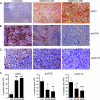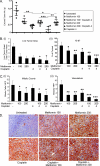Metformin suppresses ovarian cancer growth and metastasis with enhancement of cisplatin cytotoxicity in vivo
- PMID: 21532889
- PMCID: PMC3084625
- DOI: 10.1593/neo.11148
Metformin suppresses ovarian cancer growth and metastasis with enhancement of cisplatin cytotoxicity in vivo
Abstract
Ovarian cancer is the most lethal gynecologic cancer in women. Its high mortality rate (68%) reflects the fact that 75% of patients have extensive (>stage III) disease at diagnosis and also the limited efficacy of currently available therapies. Consequently, there is clearly a great need to develop improved upfront and salvage therapies for ovarian cancer. Here, we investigated the efficacy of metformin alone and in combination with cisplatin in vivo. A2780 ovarian cancer cells were injected intraperitoneally in nude mice; A2780-induced tumors in nude mice, when treated with metformin in drinking water, resulted in a significant reduction of tumor growth, accompanied by inhibition of tumor cell proliferation (as assessed by immunohistochemical staining of Ki-67, Cyclin D1) as well as decreased live tumor size and mitotic cell count. Metformin-induced activation of AMPK/mTOR pathway was accompanied by decreased microvessel density and vascular endothelial growth factor expression. More importantly, metformin treatment inhibited the growth of metastatic nodules in the lung and significantly potentiated cisplatin-induced cytotoxicity resulting in approximately 90% reduction in tumor growth compared with treatment by either of the drugs alone. Collectively, our data show for the first time that, in addition to inhibiting tumor cell proliferation, metformin treatment inhibits both angiogenesis and metastatic spread of ovarian cancer. Overall, our study provides a strong rationale for use of metformin in ovarian cancer treatment.
Figures





References
-
- Jemal A, Siegel R, Xu J, Ward E. Cancer statistics, 2010. CA Cancer J Clin. 2010;60:277–300. - PubMed
-
- Aletti GD, Gallenberg MM, Cliby WA, Jatoi A, Hartmann LC. Current management strategies for ovarian cancer. Mayo Clin Proc. 2007;82:751–770. - PubMed
-
- Ben Sahra I, Le Marchand-Brustel Y, Tanti JF, Bost F. Metformin in cancer therapy: a new perspective for an old antidiabetic drug? Mol Cancer Ther. 2010;9:1092–1099. - PubMed
Publication types
MeSH terms
Substances
LinkOut - more resources
Full Text Sources
Other Literature Sources
Medical
Research Materials
Miscellaneous
